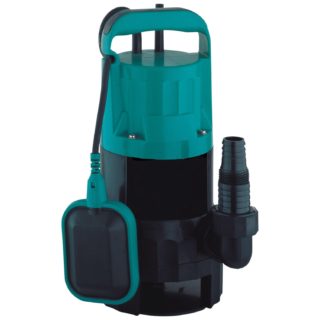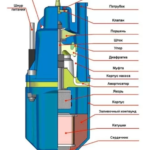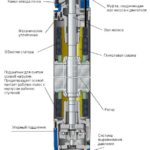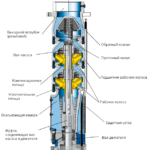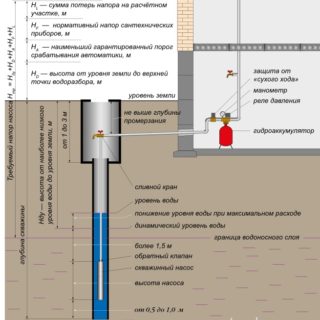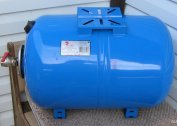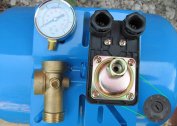When buying or building a private, the problem of water supply always comes to the fore. This can be a well or a well, from which it is necessary to organize the delivery of water to the house. This can be done using a pump and pipes.
Benefits of Well Submersible Pumps
Pumping equipment is selected depending on the depth of the source. Surface pumps and stations are not capable of pumping liquid from a depth below 8 meters. Next, you need to install an ejector, which will be very expensive. It is much more profitable to purchase immersion equipment, especially since there are several varieties on sale - you can choose according to price, design, brand of the manufacturer and technical specifications.
The well is most often located at some distance from the house - in the garden. This is another advantage in favor of the submersible pump, since the horizontal section of the track also requires power: 1 meter of vertical liquid lift equals 10 meters of horizontal transportation.
When using submersible equipment, you do not have to equip the caisson for the pump station, but this is an additional cost. The pipe simply joins the outlet pipe of the unit and stretches into the room where the accumulator is located, and then into the house.
The submersible pump housing is completely in the thickness of the liquid, so the noise of the operating equipment will not annoy. Cold water in the well prevents overheating of the device, which increases its service life.
For the well, you can choose any model, even a vibration one, since a wide area of the inner space reduces outgoing waves and the bottom does not silt, as happens with a well.
Since not all wells reach the sandy horizon, many of them feed on the tip, it is necessary to constantly monitor the liquid level. For this purpose, submersible units have automatic sensors that turn off the pump if the liquid level is below a critical level.
Surface or submersible equipment is used for installation in wells or wells. With it, you can organize watering a summer cottage or delivering water to a house for domestic needs. For installation in a well, a drainage pump can also be used. It is less sensitive to dirty water and can only be used for irrigation.
Types of models, device
If the depth of the source does not exceed 6 - 7 meters and it is not far from the water intake point, a pumping station equipped with a hydraulic accumulator is quite suitable. For work, it remains to connect the outlet pipe to the feed pipe and lower the hose into the water. For the pumping station, it is necessary to equip a warm room - a barn, a basement or a caisson.
If you install a surface pump, you will need to buy a hydraulic accumulator in order to reduce the frequency of switching on the device. It is frequent trips that lead to breakage. The pump housing is located on the surface of the earth, so the noise level rises sharply.
Varieties of submersible pumps for a well
A submersible centrifugal pump for a well is an optimal solution if the distance to the water mirror exceeds 8 meters. It should be borne in mind that in sand wells and wells, the liquid level in the summertime can drop significantly and you need to be prepared for the fact that you have to lower the pipe so that water flows into the house.
Centrifugal pumps are the most powerful and productive.They have certain disadvantages, but not significant:
- if the water in the well contains sand or stones, the impeller can wear off and then productivity decreases;
- the high cost of high-quality units, since the internal parts are made of durable materials that can withstand friction for a long time.
Vibration pumps are less powerful, in addition, limited by the distance to the water mirror. They are more suitable for wells than for wells, since the excitement that is created in the water due to vibrations does not affect the source siltation rate so much. Of the shortcomings - a short life. Advantage - do not affect the process of destruction of the walls of the well, as they are located far from them.
Vortex pumps, in which the principle of operation is similar to centrifugal pumps, have higher performance due to the presence of grooves on the walls. They accelerate the progress of the fluid. The vortex pump device is simple, so it costs less. The service life is shorter than that of centrifugal models. Also, the equipment is sensitive to solid impurities.
You can consider screw models, but they are rarely found on sale. They create a strong pressure, which can be an important parameter if the well is far from home. Units pump well dirty fluid and internal parts do not break. Frequent maintenance may be required due to the large number of rubbing elements inside the housing. The efficiency of such pumps is much lower than that of centrifugal pumps.
- Vibrating
- Vortex
- Centrifugal pump
- Screw
Principle of operation
The principle of operation of any pump without a hydraulic accumulator is to turn on each time the use of water in the house begins. This leads to rapid wear of the electric motor, since the main load falls precisely at the time of switching on. This principle can be useful only if you need a uniform supply of fluid for a long time, for example, when watering.
In other cases, it is necessary to install a hydraulic accumulator, which accumulates a supply of water. The pump is less likely to operate, therefore, runs longer. The principle of operation of the accumulator is to maintain certain pressure limits. This is done using a relay and pressure gauge. If the pressure in the system drops below the set level, the equipment starts up and pumps liquid into the tank. It turns off when the pressure gauge needle reaches the upper peak value. Then you can use the tap several times until the pressure drops again.
The upper pressure should not be higher than that which is provided for household appliances, for example, a washing machine.
Criterias of choice
When choosing a device, pay attention to the following criteria:
- Power of an electric motor and its technical characteristics. You may have to buy a voltage regulator separately to keep the engine stable. It is better if a separate branch in the electric network is allocated for the pump.
- The pressure of the water column is an important point if the pipe line runs horizontally underground. This parameter is calculated by the formula, adding the horizontal lifting height and the vertical length of the highway divided by 10. Plus, the water pressure in the house should be about 2 bar.
- The amount of fluid that a pump can pump per unit of time. The flow rate of the well plays a role here, since the productivity of the equipment cannot be higher than the amount of fluid that the source can produce at the same time.
- The dimensions of the body do not play a role, this indicator is important for the well. It is better to choose a model with a lower water intake, in which case water can be pumped out even at a very low level.
- The level of fluid contamination in the source.
- Availability of protection sensors.
- Materials for the manufacture of the housing and internal parts.
- The length of the electric cable, depending on the location of the well and the outlet.
- Noise level.
The brand of the manufacturer may also influence the choice. There are companies that have proven themselves in the pumping equipment market. Buying such a device, you can count on a long uninterrupted operation.
Installation and Connection
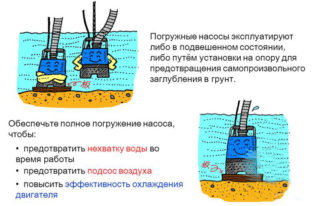 Any beginner can connect the pump to the supply pipe and the output flange, as the process is described in detail in the instructions. Another thing is to adjust the operation of the system as a whole, first of all, the accumulator. The pumping stations are already factory-set, and the submersible pump requires the connection of a hydraulic accumulator, and then all measuring instruments and pressure sensors. By twisting the big and small springs on the relay, you can set your own parameters for switching the unit on and off.
Any beginner can connect the pump to the supply pipe and the output flange, as the process is described in detail in the instructions. Another thing is to adjust the operation of the system as a whole, first of all, the accumulator. The pumping stations are already factory-set, and the submersible pump requires the connection of a hydraulic accumulator, and then all measuring instruments and pressure sensors. By twisting the big and small springs on the relay, you can set your own parameters for switching the unit on and off.
Features of operation and maintenance
During operation, it is necessary to monitor how often the surface or submersible pump is turned on. If the frequency has increased, and the fluid flows unevenly, intermittently or with air, you must check the integrity of the membrane in the GA. If necessary, replace it with a new one.
The absence of an overheating or dry running sensor can cause the equipment to work out of fluid and burn out. In this situation, you need to get ready to buy a new pump or do expensive engine repairs.
1 - 2 times a year, it is necessary to raise the immersion unit to the surface, inspect it for siltation. It often happens that the body is clogged with small fractions of sand and needs to be cleaned.
If you regularly carry out maintenance of the device, its operation will be durable and stable.
Prices for well pumps with automatic equipment for water supply at home are higher than for equipment without sensors. Such additional costs fully pay for themselves - not always tenants can notice a decrease in the water level in the source, automation will do it for them. If the pump stops turning on, you will have to find out the cause and lower the unit lower in the water column so that the sensor stops responding to danger. Do not save on relatively cheap things if the well is not stable in terms of fluid level.
